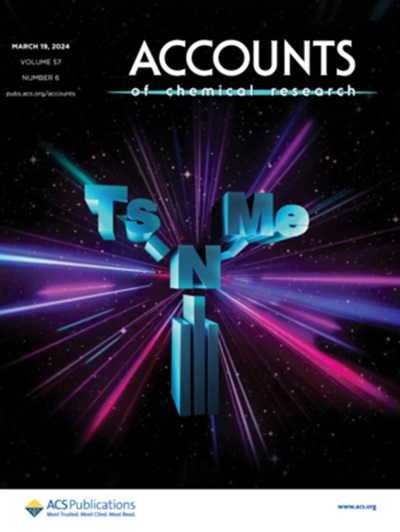电喷雾电离质谱法研究含镧系元素团簇的组装
IF 17.7
1区 化学
Q1 CHEMISTRY, MULTIDISCIPLINARY
引用次数: 0
摘要
具有明确晶体结构的原子精度金属团簇已成为配位和材料化学中一个快速发展的领域。其中,含镧元素团簇(lcc)因其美观的结构和有趣的性质而特别引人注目。实现这些簇的精确合成和准确的结构表征对于释放它们的潜在应用至关重要。质谱(MS),特别是电喷雾电离质谱(ESI-MS),已被证明是一种强大的工具,在揭示金属团簇的形成机制和结构细节方面提供了卓越的灵敏度和清晰度。在这篇文章中,我们利用ESI-MS探讨了lcc的合成、表征和组装机制。我们首先追溯lcc的历史发展,强调单晶x射线衍射在结构确认中的关键作用以及与之相关的挑战。然后,我们讨论了ESI-MS在表征lcc中的应用,重点介绍了该技术如何监测lcc的形成过程并确定其分子量和电荷状态。本文介绍了质差同构指纹图谱(MDFI)方法,该方法可以快速分析lcc的质谱数据。此外,我们还讨论了lcc在解决方案中的状态及其表征中的挑战。通过ESI-MS,我们加深了对lcc组装机制的理解,并提出了设计和合成具有定制结构和功能的新型lcc的新策略。展望未来,ESI-MS方法将在LCC研究中发挥越来越重要的作用。这些技术的持续发展将加深对结构-性质关系的理解。随着计算化学和信息科学的不断融合,我们预计lcc的设计和合成将更加精确,从而在磁性、光学和催化领域得到更广泛的应用。本文章由计算机程序翻译,如有差异,请以英文原文为准。

Electrospray Ionization Mass Spectrometry Insights into the Assembly of Lanthanide-Containing Clusters
Atomically precise metal clusters with well-defined crystal structures have emerged as a rapidly growing field within coordination and materials chemistry. Among them, lanthanide-containing clusters (LCCs) are particularly notable for their aesthetically pleasing architectures and intriguing properties. Achieving precise synthesis and accurate structural characterization of these clusters is crucial for unlocking their potential applications. Mass spectrometry (MS), particularly electrospray ionization mass spectrometry (ESI-MS), has proven to be a powerful tool, providing exceptional sensitivity and clarity in revealing the formation mechanisms and structural details of metal clusters. In this Account, we explore the synthesis, characterization, and assembly mechanisms of LCCs utilizing ESI-MS. We begin by tracing the historical development of LCCs, emphasizing the critical role of single-crystal X-ray diffraction in structural confirmation and the challenges associated with it. We then discuss the application of ESI-MS in characterizing LCCs, highlighting how this technique can monitor the formation processes of LCCs and determine their molecular weights and charge states. We introduce the mass difference fingerprint of isomorphism (MDFI) method, which can facilitate rapid analysis of LCCs’ mass spectrometry data. Furthermore, we discuss the state of LCCs in solution and the challenges in their characterization. By utilizing ESI-MS, we enhance the understanding of the assembly mechanisms of LCCs and propose new strategies for designing and synthesizing new LCCs with tailored structures and functions. Looking forward, the ESI-MS method will play increasingly significant roles in LCC research. The continued development of these technologies will deepen the understanding of the structure–property relationships. With the ongoing convergence of computational chemistry and information science, we anticipate more precise design and synthesis of LCCs, leading to broader applications in magnetism, optics, and catalysis.
求助全文
通过发布文献求助,成功后即可免费获取论文全文。
去求助
来源期刊

Accounts of Chemical Research
化学-化学综合
CiteScore
31.40
自引率
1.10%
发文量
312
审稿时长
2 months
期刊介绍:
Accounts of Chemical Research presents short, concise and critical articles offering easy-to-read overviews of basic research and applications in all areas of chemistry and biochemistry. These short reviews focus on research from the author’s own laboratory and are designed to teach the reader about a research project. In addition, Accounts of Chemical Research publishes commentaries that give an informed opinion on a current research problem. Special Issues online are devoted to a single topic of unusual activity and significance.
Accounts of Chemical Research replaces the traditional article abstract with an article "Conspectus." These entries synopsize the research affording the reader a closer look at the content and significance of an article. Through this provision of a more detailed description of the article contents, the Conspectus enhances the article's discoverability by search engines and the exposure for the research.
 求助内容:
求助内容: 应助结果提醒方式:
应助结果提醒方式:


